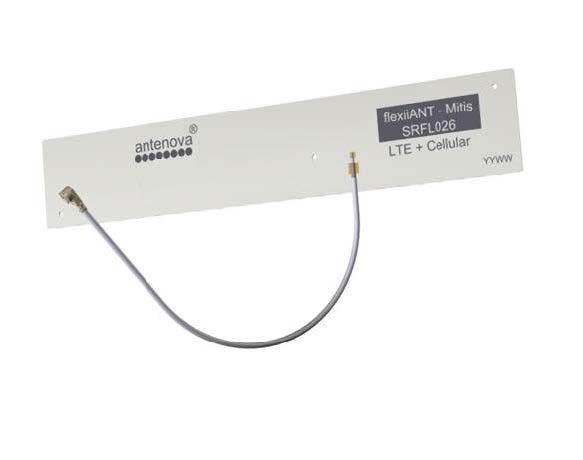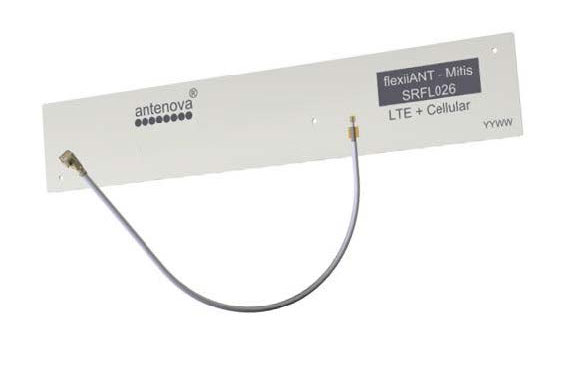It’s rare to find an external antenna on an Internet of Things device these days. No longer are these large, obtrusive antennas appended to every device. Advances in embedded RF performance and innovative design techniques have made it easier than ever to use one.
While it has never been easier to integrate an SMD antenna, more designs are pushing their performance to the limit. In many tiny devices, antennas are not given the ground plane space they need to perform well. But there is a middle ground – in the form of flexible circuit antennas, FPCs.
What is an FPC antenna?

Mitis. FPC antenna for LTE. p/n SRFL026. Download the full product specification.
FPC, standing for flexible printed circuits, are sometimes called internal flex circuits. While they have a variety of names, they all refer to the same type of antenna.
An FPC antenna marries together the benefits of both embedded and externally-mounted antennas. While they do not extrude the device, they offer high levels of performance, much like an external antenna.
They are often very thin (0.15mm thick) and come with a peel-back strip. This strip means that the antenna can be affixed to the device in a number of ways. This flexibility and performance potential makes them an exciting prospect for designers.
The benefits of flexible printed circuit antennas
Integration flexibility
FPC antennas offer the most flexible integration options of any type of antenna. They are designed to be bent, meaning they can be placed inside small IoT devices where circuit board space is at a premium.
In terms of placement, they can be put vertically, horizontally or co-planar to the host PCB. They will operate well flat, on a curve or even when folded to a certain degree. This means that they are ideal for devices where an SMD antenna simply will not fit on the host PCB with the required ground plane.
Plug in and play (almost!)
Supporting UFL cable standards (and other connectors), FPC antennas can be customised with a bespoke cable length that enable easy connection to a module and the host PCB. All you need to consider is that increasing the length of this cable substantially will have an adverse effect on the performance of the antenna.
No ground plane
The size of a PCB and the ground plane it is afforded will directly influence the performance of an SMD antenna. No such issues are presented with FPC antennas, as the flexible circuit is designed specifically for the antenna placed upon it. This enables space-saving, higher levels of performance, and fewer integration steps.
Simpler integration
FPC antennas do not always require a matching circuit. In most cases, they can be integrated without a Pi network, meaning that they offer close to plug’n’play integration for a device. This opens up the unique possibility of retrofitting an antenna, something you simply cannot do with an SMD antenna.
Performance advantages
In a world where many devices require certification, be that for network approval or PTCRB certification, they can be a great option to easily achieve the required performance levels.
Their omni-directional radiation pattern and high levels of efficiency offer similar levels of performance to a terminal (external) antenna. Achieving these levels of performance is easier, as less groundwork is required to optimise the circuit board for their function.
Application diverse
Due to all of these advantages, FPC antennas can be found in a wide range of applications and device types. They are frequently used in smart meters, where they can be retrofitted within an existing design, avoiding the costs incurred with significant design projects. Within telematics, they are able to be added in easily to enable wireless features, once again providing a performance advantage and integration advantage over SMD antennas. In retail, FPC antennas can also be found in point of sale devices.
Less expensive than external antennas
Another key advantage of an FPC antenna is that they are cheaper than externally mounted antennas, meaning you can retain high levels of performance without the expense of deploying an external mount antenna.
Faster time-to-market
Compared to a laser direct structure antenna, FPCs can offer a considerably quicker route to market, all while proving to be less expensive. LDS antennas are expensive, especially where manufacturing is not occurring at very high volumes. Even in first-generation devices, FPC antennas are typically preferred until demand has been proven.
Is an FPC antenna right for your project?
While FPC antennas are much easier to integrate into a device, there are some considerations to keep in mind while selecting one for a design. For example, they work well within small devices, but for highly-compact devices such as wearables, designers often bend and fold FPC antennas beyond the recommended limits, reducing their performance.
The material used for the housing is also important. They work well for relatively thin plastic housings, whereas metal product housings are likely to cause issues (as they would also for any other sort of SMD antenna).
In regards to placement, FPC antennas should be mounted away from metal components and surfaces, ideally 20mm away to enable the antenna to radiate efficiently. As a minimum requirement, metallic materials should be 10mm away. Customisable cable lengths are also available, but they may be subject to MoQ requirements, as stipulated by the manufacturer.
Introducing flexiiANT
Antenova is leading the way for flexible circuit antennas, with a selection of FPC antennas designed specifically for a wide range of wireless technologies. The product family, flexiiANT, has options that cover Wi-Fi, Bluetooth, Cellular, ISM and LPWAN bands, enabling devices of all categories to benefit from these antennas.
Antenova’s flexiiANT family has been created under the company’s designed for integration ethos. This ethos means that Antenova antennas are made specifically to speed up the integration process, with minimal fuss and optimal performance.
For more information about flexiiANT, see the full range or get in touch with your local Antenova sales representative to learn more about these innovative antennas. Antenova offers bespoke design and custom tuning options exclusively to customers, so get in touch for more information.




